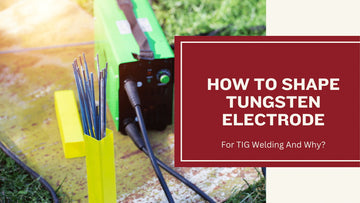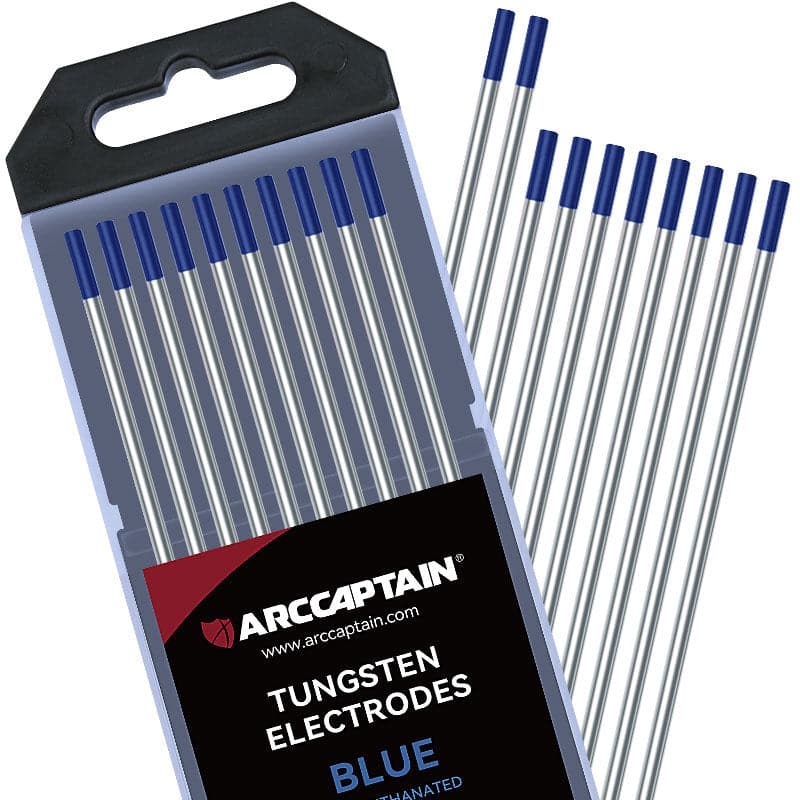
Mastering the art of TIG welding hinges on one crucial aspect: selecting and shaping the right tungsten electrode. The difference between a perfect weld and common issues like poor penetration or arc instability often lies in the electrode tip. In this straightforward guide, we'll show you how to choose and prepare the tungsten tip that fits your specific welding needs.
TIG welding, known for its precision and widespread use in industries across the United States, Europe, and Japan, demands a deep understanding of electrode characteristics, including its melting temperature and shape.
By the end of this article, you'll have a clear grasp of how to achieve optimal results in your TIG welding projects through proper tungsten electrode preparation.
Tungsten Tip Shapes - Which To Use?
When it comes to TIG welding, the tungsten electrode tip shape you need to use depends on the welded materials, joint thickness, and the bead profile you wish to make. You can weld all metals with a pointed or truncated tungsten electrode using AC and DC TIG welding current. But, welding aluminum may sometimes require a balled, hemispherical tungsten tip. However, pointed tungsten with a small ball at the end works well too. Let's discuss the different tip shapes and how they impact the weld.
AC TIG Welding Of Aluminum - Tungsten Shape
When welding aluminum with AC TIG welding, you may need to ball up your tungsten electrode's tip. This is a well-accepted practice used for decades when AC TIG welding aluminum. But, you don't have to completely ball up your tungsten electrode as was necessary in the past.
If your AC TIG welding machine has the ability to set the AC balance between DCEN (penetration) and DCEP (cleaning action), you can reduce the DCEP, and you won't need to ball up the tungsten electrode. The positive current (DCEP) is what concentrates too much heat on the tungsten electrode and causes it to ball up or even melt away. However, if you use a pointed tungsten electrode with adequate thickness for the amperage you are using and reduce the DCEP to 30% or below, your tungsten tip will only slightly ball up. As a result, you can weld with more precision.
But, you should also try a fully balled-up tungsten tip to know which one you'll like the best. To ball up your tungsten electrode, you need to set the AC balance as high as possible to the DCEP side. So, adjust the DCEP to a maximum and DCEN to a minimum. This will focus most of the energy on the tungsten electrode tip. Afterward, proceed to initiate an arc on a scrap piece of metal with high amperage to melt the tungsten tip into a ball shape. Check the electrode specification if the manufacturer suggests the ball-up amperage. If not, try different amperage settings until you find the sweet spot. Keep in mind that an overly strong current can melt thin tungsten rods with a high DCEP balance setting.
An alternative is to use a DC TIG welding helmet output with the TIG torch attached to the positive polarity and the ground clamp attached to the negative polarity. Essentially, this achieves the same result. The electrode is positive (DCEP), and since tungsten cannot withstand the concentrated current on its tip, it melts and turns to a ball shape. The size of the hemisphere ball at the tungsten's tip should not exceed 1-½ times the electrode's diameter. If it does, the ball may fall off when heated.
Keep in mind that pure tungsten or zirconated tungsten electrodes are used when AC TIG welding aluminum. They ball up the best and have good arc characteristics.
Tungsten Tip Shapes
Sharply ground tungsten tips, between 15 and 30-degree angles, provide lower penetration and wider bead profile. Additionally, the arc is more stable, but the chances of tungsten erosion and weld contamination are higher. Larger than 60-degree angles provide higher penetration but a more narrow bead profile. These electrode tips are less likely to erode in the weld pool, but the arc is prone to wandering, which reduces arc control.
A 30 to 60-degree tip angle provides the best of both worlds for most jobs. You get adequate penetration and excellent arc stability. But the exact angle depends on your preferences and welding technique. So you should try a few angles to find the tip shape that suits you the best.
However, you can benefit from very low tungsten grind angles when welding outside corner joints or thin stock. A sharp, 15-degree angle will widen the arc coverage and reduce penetration, which is often desirable when welding outside corner joints or performing lap welds.
After sharpening the tungsten to desired grind angle, it's often a good idea to flatten the tip slightly. This will prevent tungsten erosion and tiny tungsten particles from contaminating the weld joint. But don't overdo with the flattening. The width of the flat tip should only be about 10% of the tungsten electrode width.
In summary, the tungsten electrode tip shape you need to use depends on the welded materials, joint thickness, and the bead profile you wish to make. When welding aluminum with AC TIG welding, you may need to ball up your tungsten electrode's tip. Sharply ground tungsten tips, between 15 and 30-degree angles, provide lower penetration and wider bead profile. A 30 to 60-degree tip angle provides the best of
Tungsten Electrode Shaping Methods
You can either grind or dip the tungsten in the chemical solution to form it into a sharp point. However, since grinding offers you more control over the outcome and is more dependable, almost everyone grinds their tungsten electrodes.
-
Tungsten Electrode Shaping:
- Methods: Grinding (most reliable) or chemical solution.
- Benefits: Better control, allows flattening, cuts off contaminated parts.
-
Manual Grinding:
- Tool: Grinding wheel.
- Technique: Tungsten axis perpendicular to grinding wheel, grind linearly, not around.
- Results: If done wrong, arc wanders, risk of tungsten inclusions.
-
Safety with Thoriated Tungsten:
- Thoriated Tungsten: Contains radioactive thoria (red color).
- Safety Measures: Use mask respirator, local dust extraction.
-
Tungsten Electrode Geometry and Welding:
- Influences: Arc shape, weld bead size/shape, penetration, electrode life.
- Factors: Diameter, tip, configuration, preparation.
- AWS Standard: Color coding for types, lengths, diameters.
-
Grinding Technique and Tools:
- Correct Technique: Avoid jagged edges, roughness.
- Best Grinding Wheels: Diamond grinding wheels.
See Related Article: How To Choose The Right Welding Helmet
Trust ArcCaptain For Your Tungsten Electrodes
When it comes to welding, the angle of your tungsten tip can make a big difference. While a truncated, 30-degree angle works for most jobs, a 15-degree grind angle is best for welding thin metals.

At ArcCaptain, we offer a variety of tungsten electrodes to suit your needs, from pure tungsten to lanthanated, ceriated, and thoriated. Trust us to provide you with the right tungsten electrode for your welding needs.
Frequently Asked Questions
What are the recommended shapes for tungsten electrodes when TIG welding different materials?
The recommended shape for a tungsten electrode when TIG welding different materials depends on the thickness of the material being welded. For thin materials, a pointed electrode is recommended, while for thicker materials, a flat or truncated cone-shaped electrode is recommended. The shape of the electrode also depends on the type of material being welded.
How does the shape of a tungsten electrode affect TIG welding performance?
The shape of a tungsten electrode affects TIG welding performance in several ways. A pointed electrode provides a more focused arc, which is ideal for welding thin materials. A flat or truncated cone-shaped electrode provides a wider arc, which is ideal for welding thicker materials. The shape of the electrode also affects the amount of heat input into the material being welded.
Which grinding wheel should be used for shaping a tungsten electrode?
A diamond grinding wheel is recommended for shaping a tungsten electrode. This type of grinding wheel provides a consistent grind and is less likely to contaminate the electrode with foreign materials. It is also important to use a dedicated grinding wheel for tungsten electrodes to prevent damage to the grinding disc.
What are the size considerations for tungsten electrodes in relation to TIG welding applications?
The size of the tungsten electrode used in TIG welding depends on the thickness of the material being welded. For thin materials, a smaller diameter tungsten electrode is recommended, while for thicker materials, a larger diameter tungsten electrode is recommended.
How do you properly secure a tungsten electrode in a TIG welding torch?
To properly secure a tungsten electrode in a TIG welding torch, the electrode should be inserted into the collet and tightened using the collet body. It is important to ensure that the electrode is centered in the collet and that the collet is tightened securely to prevent the electrode from moving during welding.
What are the differences between thoriated tungsten and other types of tungsten electrodes?
Thoriated tungsten electrodes are a type of tungsten electrode that contain a small amount of thorium oxide. This type of electrode is commonly used in DC welding applications and provides a stable arc and good electrode life.




